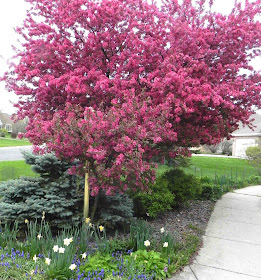Several years ago, in a post about the dangers of monoculture manifested as the "pistachio disaster," I offered this comment:
We and our neighbors became familiar with anthracnose when it spread through our subdivision several years ago in the form of "apple scab" on the beautiful (and popular) crabapple trees. The leaves developed black lesions and fell early from the tree. If any of you notice something similar with your apple/crabapple trees, be sure to call an arborist, because although the tree can tolerate partial defoliation, if it happens several years in a row, it can kill the tree.The crabapple is one of the focal points of our front garden in the spring, when the floral display bursts into flame and it becomes abuzz with pollinating insects, and once again weeks later when the petal drop...
... makes us feel like emperors treading a victory path.
The "apple scab" seemed to end years ago after treatment of the tree and after we raked up and discarded all the infected fallen leaves. But... the arborist has been returning annually to retreat the tree with a "spring foliar spray" at $120 per year, and this year I've decided to withhold treatment in order to redirect the funds to other purposes. Any advice from those of you with experience in such matters? Can we just wait and leave the tree untreated and monitor it for the return of the apple scab, or is it latent and ready to devastate the tree again?
Followup 2017:
We stopped the annual treatments after I wrote that post in 2013. The tree thrived in 2014, 15, and 16. This year the apple scab returned. In mid-June we have a substantial leaf drop that will stress but not kill the tree (I see several in the neighborhood that are more severely affected, presumably in their second or third year of infection, and possibly where the spores came from that landed on our tree).
I contacted a different arborist this year. They will plan to inject our tree next spring, before leafout, with Tebuject (an injectable fungicide). Whether that will be longer-lasting and whether it needs to be repeated annually I do not know. Cost is $136 for a one-time rx.


Ask over at Gardenweb.com. Marvelous folks from all over with great advice.
ReplyDelete